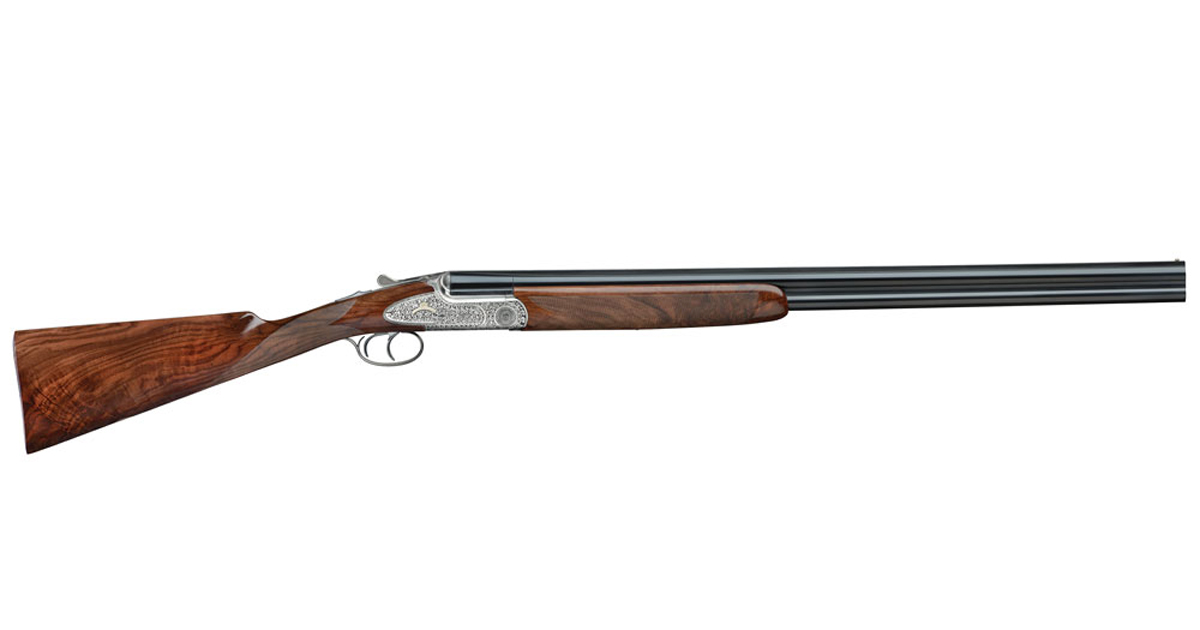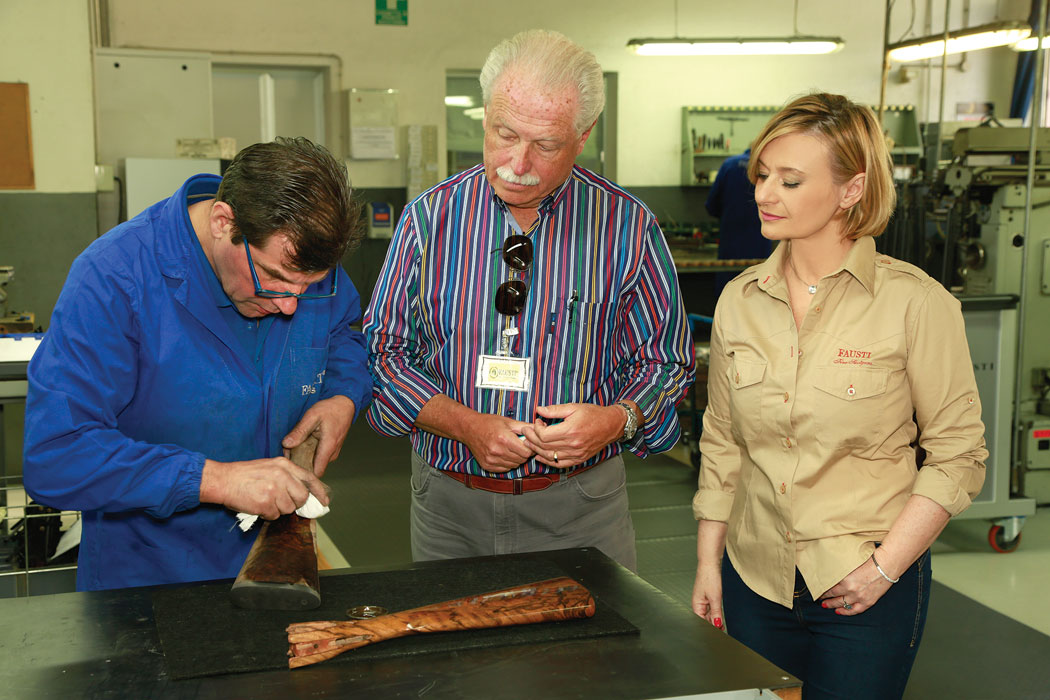Celebrating a gunmaking milestone
By Silvio Calabi
Images Courtesy of Fausti
Italy after the Big War was a mess. Like much of Fortress Europe, it had been ground down by American and British bombers and overrun by Allied infantry. You’d never know it today, though. From the Alps to Sicily, the country teems with visitors admiring the world’s greatest assemblage of Classical and Renaissance antiquities; and modern Italy is a powerhouse in culture, couture, cuisine, transport (sports cars, motorcycles, boats, ships) and more, including guns—military, replica and sporting.
The war ended in 1945. In ’46 a nationwide election replaced Italy’s monarchy with a republic, and in ’47 a new constitution was adopted. A year later the Christian Democrats became Italy’s ruling political party and—with massive American aid—ignited the second Italian Renaissance. Also in 1948, way up north in Val Trompia, a teenager named Stefano Fausti began making guns.
Fausti’s company flourished and grew, as did his family—three now-famous children named Elena, Giovanna and Barbara. For his contributions to commerce, Stefano was knighted and awarded the Order of Merit of the Italian Republic. For their hard work and interest, Elena, Giovanna and Barbara inherited the company. Stefano is now 89 years old and button-burstingly proud of his daughters and the fact that his company has reached the ripe age of 70.

Combining tradition with innovation has helped Fausti thrive through the decades and produce guns for a wide slice of the market.
Like their papa, Elena, Giovanna and Barbara also seem to be archetypal daughters of their culture: quick, intelligent, articulate, not short of humor, industrious and focused on both the big picture and the details. On my visit, in May, I was received warmly.
Giovanna, the middle daughter, took the lead; she is the CEO and responsible for sales in the US. Barbara, the youngest, looks after Europe and the UK. Elena, the eldest, is the production manager and deals with suppliers. All three ladies are very personable—thoroughly Italian, in other words. At lunch Elena, who I’d only glimpsed all morning, introduced herself and joked, “No, I’m the youngest.”
The sisters went to school for accounting and languages, but they also took evening classes to learn to read technical drawings and to develop the skills that allow them to work side by side with the company’s engineers. The ability to talk not only with customers but also designers has been a key to the firm’s success. “We think it’s important to be able to communicate [in English] about our products and our passion directly,” Giovanna said.
The sisters also have taken up shooting and hunting, and they continually invest time, cash and energy in their work and passions. Giovanna believes that their background of studies and field experience have helped them overcome any prejudices about gun companies run by women.
From 1948 until 1996, Stefano Fausti had grown the business to a very respectable 12,000 or so guns per annum, largely for Europe and relying a great deal on outsourcing. It was a comfortable living, but retirement beckoned and here were the daughters, itching to innovate. After studying the new double-gun market, especially abroad, Elena, Giovanna and Barbara proposed a transformation of the company: Shift away from mass production; bring everything in-house; expand into small gauges; and sharply cut the number of guns going out the door while raising their variety, quality and price. Papa blessed the plan, and today it is mission accomplished—or at least well underway. Some 40 employees now turn out about 3,500 guns annually, including a few for other companies to sell under their own names.
Barbara’s husband, Fabio, is the product manager, and he led me around the 13,200-square-foot factory demonstrating one new computerized multi-axis machining center after another. (As an ex-shop foreman, I was particularly taken with the ThermoGrip tool holders, which use heat to shrink-fit collets around milling cutters. Tools are gripped securely and concentrically, with no possibility of vibration, and changing them is fast and easy.)

The author (middle) and Giovanna Fausti admire an artisan finishing a stock..
As every modern gunmaker has learned, computerized production costs more up front, but it reduces the need for highly experienced (and expensive) artisans. Computers also can produce small runs of parts to tight tolerances in short time spans. However, at Fausti it is a point of pride not to make only perfectly interchangeable components by automation. “We prefer final hand-fitting,” Fabio said. He also pointed out the constant quality-control checks made along the way and that a $5,000 gun and a $100,000 gun both receive the same scrutiny.
Flexibility in manufacturing—as well as thinking and design—helped Fausti weather the economic crisis of 2009 by rapidly creating new guns for new markets such as Russia. That same year, with an eye toward better serving existing American clients as well as reaching new shooters, the firm established Fausti USA—with offices, a warehouse, a service center and a gunroom in Fredericksburg, Virginia.
In 2017 the company capitalized on its growing popularity in England by opening Fausti UK in collaboration with Stag Country Sports, in North Yorkshire. And more recently Fausti has taken a stand at San Antonio’s National Shooting Complex as a way to reach the competitive side of the market.
In addition to overseeing the various locations, Giovanna and Barbara travel about four months each year to attend trade shows and consumer events, such as the SHOT Show, Dallas Safari Club Convention and Safari Club International Convention. Often they have with them the company’s gunfitter to measure clients for custom projects.
Through these face-to-face interactions Fausti has been able to establish relationships with customers around the world and grow its business. Of course, a fair number of clients travel to Italy in order to meet the people involved and tour Fausti’s facility.
Combining computerized production with handwork is a point of pride at Fausti.
Updated production techniques have helped growth as well. As every modern gunmaker has learned, scaling actions up or down to bore size has become relatively easy with computerized design and manufacturing. Fausti was among the first to do this and now offers 12-, 16-, 20-, 24-, 28-, 32- and 67-gauge (.410-bore) barrels on seven different-size frames in side-by-side configurations and four sizes of over/under actions for 12-, 16-, 20- and 28-gauge guns. (The company also makes double rifles for cartridges from .243 Winchester and 7x57R up to .45-70 and .444 Marlin.) The frames, or action bodies, are whittled in-house out of steel blanks supplied by a nearby forge; most barrel forgings come from Germany and are welded to their monoblocks at a specialized shop four miles away. Fausti guns contain no castings or stampings, and nearly all of even the smallest components are machined in-house, although heat-treating and bluing are still done outside.
The great majority of break-action Fausti guns and rifles (the company also makes a few semi-automatic shotguns) are built on an evolution of the classic Anson & Deeley boxlock action with monoblock barrels. Some more-expensive A&D guns have sideplates. The wood is Turkish walnut. Just as most larger gunmakers in Val Trompia do, Fausti buys roughed-out stock blanks from a supplier just around the corner, and then fits and finishes them to each gun by hand.
Fausti presently builds only about a dozen guns per year with demiblock barrels. These guns are bespoke—made to order and fitted to the buyer—and mated to sidelock actions and typically engraved by the top artisans in the valley. Such guns are expensive but generally cost much less than “best” guns from London.
Along with paying close attention to markets, Fausti carefully analyzes, costs out and controls its gunmaking processes—typically 90 mechanical steps with at least 50 manual “interventions” along the way, adding up to a base of 150 hours—to which may be added another 100 hours for bespoke guns and 300 or more hours of hand-engraving.

The Fausti USA website distinguishes between Core (guns that customers can find with American dealers) and Boutique guns. The former list for about $3,700 to $6,300; the latter are based on Core guns but priced according to the customer’s desires for fitting and options. Machine checkering or hand, laser engraving or hand, blued or coin finishes, screw-in or fixed chokes, ribs, hand-detachable sidelocks, single or double triggers, external hammers, extra sets of barrels, premium wood, recoil pads, special cases, standard dimensions or bespoke—they’re all available and all POA, price on application.
One of the company’s most unusual and costly orders was a set of four top-grade shotguns, each tailored and engraved to a different stage of the owner’s life. And in the showroom I discovered another unusual item: a cased pair of howdah pistols—round-body, double-barreled 12-bore handguns engraved in tight scroll and lavishly gold-inlaid, with silver butt caps on marbled dark stocks. Just another one-off project for a Fausti aficionado.
And what’s a big birthday without presents? Fausti has created two series of 70th Anniversary shotguns, each limited to 70 guns and each gun specially engraved and signed. The anniversary side-by-sides are offered in 16-, 20-, 28- and 32-gauge as well as .410; the over/unders in 16-, 20- and 28-gauge and .410. Both are gorgeous guns with round-body frames to scale, long-profile sideplates and long trigger guards.
The Fausti philosophy is to make the best possible guns, with no compromises, accessible to a broad slice of the market. To do this, the company—the family—combines tradition with innovation; strives to update its methods and materials as technology advances; and refines its product mix in step with the market. For example, years ago Fausti anticipated the growth in smallbore shooting: “It became important to hunt not just to kill numbers of animals but to enjoy the outdoor life,” Giovanna and Barbara both have said. “Now many people prefer hunting with guns like the 28 or .410, which also open the market to women and younger shooters.”

The 70th Anniversary side-by-side.
Fausti’s line of accessory and boutique items opens their market further yet. Alongside the not-unexpected gear such as shooting glasses, ear protection, gun-cleaning kits, cartridge belts, gunslips, cases, knives and logo clothing, the company also offers wristwatches. These are by Swiss maker Paul Picot and feature faces hand-engraved by Fausti artisans with game scenes or whatever the buyer fancies. Some customers have their bespoke guns and watches engraved with the same patterns or themes.
At 70 years, Fausti is one of Italy’s oldest surviving gunmakers, and its future seems assured for decades yet, thanks to the enthusiastic involvement of the family’s B Generation. (Giovanna’s and Barbara’s children are beginning to take an interest in the business as well.) At Fausti, it should be possible to shake the hand of someone by that name for a long time to come.









The 70th Anniversary guns are nice looking. Looking to get one of the new FAIR Isides.
Very interesting article, well written about another “I want it” well-made gun!
I prefer the O/U but the SxS has nice lines also.